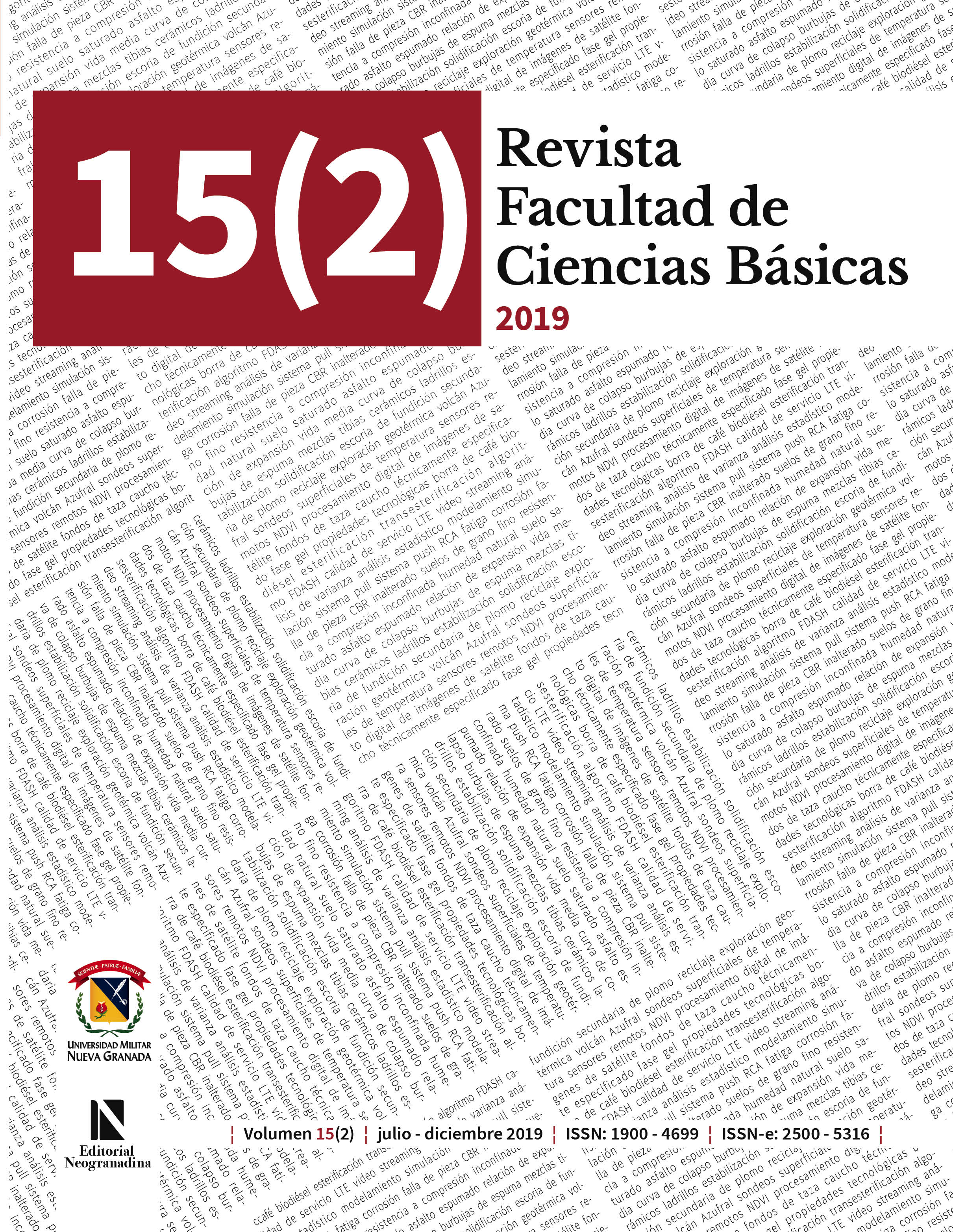Átomos individuais
Um desafio para a química verde
Resumo
A crescente demanda de diversos produtos de consumo devido ao aumento da população mundial impacta diretamente o ambiente. Em anos recentes, o estudo e desenvolvimento de novos materiais baseados em átomos individuais (SA) constituem um novo paradigma da eficiência na química verde para enfrentar os impactos negativos da superexploração das matérias-primas. Neste documento, explica-se os conceitos chave para entender os materiais baseados em SA, sua síntese, aplicações, bem como as principais técnicas analíticas para sua caracterização e sua relação com a química ambiental como elemento tecnológico chave no desenvolvimento sustentável.
Downloads
##plugins.generic.ArticleMetadataByBiteca.subjects##:
Química verde##plugins.generic.ArticleMetadataByBiteca.disciplines##:
QuímicaReferências
Alghannam, A., Muhich, C. L., & Musgrave, C. B. (2017). Adatom surface diffusion of catalytic metals on the anatase TiO 2 (101) surface. Physical Chemistry Chemi- cal Physics, 19(6), 4541-4552. https://doi.org/10.1039/C6CP08789B
Andraos, J. (2012). Inclusion of environmental impact pa- rameters in radial pentagon material efficiency metrics analysis: Using benign indices as a step towards a com- plete assessment of "greenness" for chemical reactions and synthesis plans. Organic Process Research & De- velopment, 16(9), 1482-1506. https://doi.org/10.1021/op3001405
Bond, G. C. (1974). Homogeneous and Heterogeneous Catalysis by Noble Metals, in B. J. Luberoff (Ed.), Ho- mogeneous Catalysis (pp. 25-34). American Chemical Society. https://doi.org/10.1021/ba-1968-0070.ch002
Caparrós, F. J., Guarnizo, A., Rossell, M. D., Angurell, I., Seco, M., Muller, G., ... & Rossell, O. (2017). NH 2-or PPh 2-functionalized linkers for the immobilization of palla- dium on magnetite nanoparticles? rsc advances, 7(45), 27872-27880. https://doi.org/10.1039/C7RA03639F
Castillejos, E., García-Minguillán, A. M., Bachiller-Bae- za, B., Rodríguez-Ramos, I., & Guerrero-Ruiz, A. (2018). When the nature of surface functionalities on modified carbon dominates the dispersion of palla- dium hydrogenation catalysts. Catalysis Today, 301, 248-257. https://doi.org/10.1016/j.cattod.2017.05.024
Chang, T. Y., Tanaka, Y., Ishikawa, R., Toyoura, K., Mat- sunaga, K., Ikuhara, Y., & Shibata, N. (2014). Direct imaging of pt single atoms adsorbed on TiO2 (110) surfaces. Nano letters, 14(1), 134-138. https://doi.org/10.1021/nl403520c
Chen, Y., Huang, Z., Gu, X., Ma, Z., Chen, J., & Tang, X. (2017). Top-down synthesis strategies: Maximum noble-metal atom efficiency in catalytic materials. Chi- nese Journal of Catalysis, 38(9), 1588-1596. https://doi.org/10.1016/S1872-2067(17)62778-5
Cheng, N., Zhang, L., Doyle-Davis, K., & Sun, X. (2019). Single-atom catalysts: From design to applica- tion. Electrochemical Energy Reviews, 2(4), 1-35. https://doi.org/10.1007/s41918-019-00050-6
Corma, A., & Garcia, H. (2008). Supported gold nanoparti- cles as catalysts for organic reactions. Chemical Society Reviews, 37(9), 2096-2126. https://doi.org/10.1039/b707314n
Corma, A., Concepción, P., Boronat, M., Sabater, M. J., Navas, J., Yacaman, M. J., ... & Mendoza, E. (2013). Exceptional oxidation activity with size-controlled su- pported gold clusters of low atomicity. Nature Chemis- try, 5(9), 775-781. https://doi.org/10.1038/nchem.1721
Cui, X., Junge, K., Dai, X., Kreyenschulte, C., Pohl, M. M., Wohlrab, S., ... & Beller, M. (2017). Synthesis of single atom based heterogeneous platinum catalysts: High selectivity and activity for hydrosilylation reactions. acs central science, 3(6), 580-585. https://doi.org/10.1021/acscentsci.7b00105
Deng, T., Zheng, W., & Zhang, W. (2017). Increasing the range of non-noble-metal single-atom catalysts. Chinese Journal of Catalysis, 38(9), 1489-1497. https://doi.org/10.1016/S1872-2067(17)62799-2
Dicks, A. P., & Hent, A. (2015). Atom economy and reac- tion mass efficiency. In Green Chemistry Metrics (pp. 17-44). Springer, Cham. https://doi.org/10.1007/978-3-319-10500-0_2
Dong, F., Zhao, Y., Han, W., Zhao, H., Lu, G., & Tang, Z. (2017). Co nanoparticles anchoring three dimen- sional graphene lattice as bifunctional catalyst for low-temperature CO oxidation. Molecular Catalysis, 439, 118-127. https://doi.org/10.1016/j.mcat.2017.06.022
Doyle, A. M., Shaikhutdinov, S. K., Jackson, S. D., & Fre- und, H. J. (2003). Hydrogenation on metal surfaces: Why are nanoparticles more active than single crys- tals? Angewandte chemie international edition, 42(42), 5240-5243. https://doi.org/10.1002/anie.200352124
Fei, H., Dong, J., Arellano-Jiménez, M. J., Ye, G., Kim, N. D., Samuel, E. L., ... & Yacaman, M. J. (2015). Atomic cobalt on nitrogen-doped graphene for hydrogen ge- neration. Nature communications, 6(1), 1-8. https://doi.org/10.1038/ncomms9668
Flytzani-Stephanopoulos, M. (2017). Supported metal ca- talysts at the single-atom limit-A viewpoint. Chine- se Journal of Catalysis, 38(9), 1432-1442. https://doi.org/10.1016/S1872-2067(17)62886-9
Fuechsle, M., Miwa, J. A., Mahapatra, S., Ryu, H., Lee, S., Warschkow, O., ... & Simmons, M. Y. (2012). A single-atom transistor. Nature nanotechnology, 7(4), 242-246. https://doi.org/10.1038/nnano.2012.21
Gao, Z., Yang, W., Ding, X., Lv, G., & Yan, W. (2018). Su- pport effects in single atom iron catalysts on adsorp- tion characteristics of toxic gases (NO2, NH3, SO3 and H2S). Applied Surface Science, 436, 585-595. https://doi.org/10.1016/j.apsusc.2017.12.077
González-Castaño, M., Le Saché, E., Ivanova, S., Ro- mero-Sarria, F., Centeno, M. A., & Odriozola, J. A. (2018). Tailoring structured wgs catalysts: Impact of multilayered concept on the water surface interac- tions. Applied Catalysis B: Environmental, 222, 124- 132. https://doi.org/10.1016/j.apcatb.2017.10.018
Greeley, J., Nørskov, J. K., & Mavrikakis, M. (2002). Electro- nic structure and catalysis on metal surfaces. Annual review of physical chemistry, 53(1), 319-348. https://doi.org/10.1146/annurev.physchem.53.100301.131630
Guarnizo, A., Angurell, I., Muller, G., Llorca, J., Seco, M., Rossell, O., & Rossell, M. D. (2016). Highly water-dispersible magnetite-supported Pd nanoparticles and single atoms as excellent catalysts for Suzuki and hydrogenation reactions. rsc advances, 6(73), 68675-68684. https://doi.org/10.1039/C6RA14257E
Guarnizo Franco, A. (2016). Síntesis y propiedades catalíti- cas de nanopartículas de paladio depositadas sobre na- nopartículas de magnetita. Universitat de Barcelona.
Hahn, J. R., & Ho, W. (2001). Oxidation of a single carbon monoxide molecule manipulated and induced with a scanning tunneling microscope. Physical review let- ters, 87(16), 166102. https://doi.org/10.1103/PhysRevLett.87.166102
Hansen, T. W., DeLaRiva, A. T., Challa, S. R., & Datye, A. K. (2013). Sintering of catalytic nanoparticles: Particle migration or Ostwald ripening? Accounts of chemical research, 46(8), 1720-1730. https://doi.org/10.1021/ar3002427
Haruta, M. (2003). When gold is not noble: Catalysis by nanoparticles. The chemical record, 3(2), 75-87. https://doi.org/10.1002/tcr.10053
Hedayatnasab, Z., Abnisa, F., & Daud, W. M. A. W. (2017). Review on magnetic nanoparticles for mag- netic nanofluid hyperthermia application. Materials & Design, 123, 174-196. https://doi.org/10.1016/j.matdes.2017.03.036
Hu, P., Huang, Z., Amghouz, Z., Makkee, M., Xu, F., Kap- teijn, F., ... & Tang, X. (2014). Electronic metal-support interactions in single‐atom catalysts. Angewandte Chemie, 126(13), 3486-3489. https://doi.org/10.1002/ange.201309248
Jonker, B. T. (1994). Surface adatom-adatom coordina- tion and orientation determined by low energy Auger electron and photoelectron diffraction due to adatom emission. Surface science, 306(1-2), L555-L562. https://doi.org/10.1016/0039-6028(94)91177-0
Kharissova, O. V., Dias, H. R., Kharisov, B. I., Pérez, B. O., & Pérez, V. M. J. (2013). The greener synthesis of nanoparticles. Trends in biotechnology, 31(4), 240-248. https://doi.org/10.1016/j.tibtech.2013.01.003
Kim, J., Guillaume, B., Chung, J., & Hwang, Y. (2015). Critical and precious materials consumption and requirement in wind energy system in the EU 27. Applied Energy, 139, 327-334. https://doi.org/10.1016/j.apenergy.2014.11.003
Liang, S., Hao, C., & Shi, Y. (2015). The power of single-atom catalysis. ChemCatChem, 7(17), 2559- 2567. https://doi.org/10.1002/cctc.201500363
Liu, J., Bunes, B. R., Zang, L., & Wang, C. (2018). Suppor- ted single-atom catalysts: Synthesis, characterization, properties, and applications. Environmental Chemistry Letters, 16(2), 477-505. https://doi.org/10.1007/s10311-017-0679-2
Liu, J., Jiao, M., Lu, L., Barkholtz, H. M., Li, Y., Wang, Y., ... & Ma, C. (2017). High performance platinum single atom electrocatalyst for oxygen reduction reac- tion. Nature communications, 8(1), 1-10. https://doi.org/10.1038/ncomms16160
Liu, L., & Corma, A. (2018). Metal catalysts for heterogeneous catalysis: From single atoms to nanoclusters and nanoparticles. Chemical reviews, 118(10), 4981-5079. https://doi.org/10.1021/acs.chemrev.7b00776
Liu, P., Xie, Y., Miller, E., Ebine, Y., Kumaravadivel, P., Sohn, S., & Cha, J. J. (2019). Dislocation-driven SnTe surface defects during chemical vapor depo- sition growth. Journal of Physics and Chemistry of Solids, 128, 351-359. https://doi.org/10.1016/j.jpcs.2017.12.016
MacLaren, J. M., Pendry, J. P., & Joyner, R. W. (1986). The role of adatom geometry in the strength and range of catalyst poisoning. Surface science, 165(2-3), L80-L84. https://doi.org/10.1016/0039-6028(86)90804-6
Märkl, J. T. (2015). Investigation of Magnetic Adatoms with Scanning Tunneling Techniques. Karlsruhe: kit Scientific Publishing.
Matrane, I., Mazroui, M. H., Sbiaai, K., Eddiai, A., & Bou- ghaleb, Y. (2017). Energy barriers of single-adatoms diffusion on unreconstructed and reconstructed (110) surfaces. The European Physical Journal B, 90(10), 201. https://doi.org/10.1140/epjb/e2017-80235-0
Nath, S., Jana, S., Pradhan, M., & Pal, T. (2010). Ligand-stabilized metal nanoparticles in organic sol- vent. Journal of colloid and interface science, 341(2), 333-352. https://doi.org/10.1016/j.jcis.2009.09.049
Natterer, F. D., Yang, K., Paul, W., Willke, P., Choi, T., Greber, T., ... & Lutz, C. P. (2017). Reading and writing single-atom magnets. Nature, 543(7644), 226-228. https://doi.org/10.1038/nature21371
Nørskov, J. K. (2001). Surface chemistry: Catalysis frozen in time. Nature, 414(6862), 405-406. https://doi.org/10.1038/35106674
Ogino, I. (2017). X-ray absorption spectroscopy for single-atom catalysts: Critical importance and persistent challenges. Chinese Journal of Catalysis, 38(9), 1481- 1488. https://doi.org/10.1016/S1872-2067(17)62880-8
O'Mullane, A. P. (2014). From single crystal surfaces to single atoms: Investigating active sites in electro- catalysis. Nanoscale, 6(8), 4012-4026. https://doi.org/10.1039/C4NR00419A
Pajonk, G. M. (2000). Contribution of spillover effects to heterogeneous catalysis. Applied Catalysis A: General, 202(2), 157-169. https://doi.org/10.1016/S0926-860X(00)00522-6
Parkinson, G. S. (2017). Unravelling single atom catalysis: The surface science approach. arXiv preprint arXiv:1706.09473. https://doi.org/10.1016/S1872-2067(17)62878-X
Parkinson, G. S., Novotny, Z., Argentero, G., Schmid, M., Pavelec, J., Kosak, R., ... & Diebold, U. (2013). Carbon monoxide-induced adatom sintering in a Pd-Fe3O4 model catalyst. Nature materials, 12(8), 724-728. https://doi.org/10.1038/nmat3667
Pfisterer, J. H., Liang, Y., Schneider, O., & Bandarenka, A. S. (2017). Direct instrumental identification of ca- talytically active surface sites. Nature, 549(7670), 74- 77. https://doi.org/10.1038/nature23661
Pla, J. J., Tan, K. Y., Dehollain, J. P., Lim, W. H., Morton, J. J., Jamieson, D. N., ... & Morello, A. (2012). A single-atom electron spin qubit in silicon. Nature, 489(7417), 541- 545 https://doi.org/10.1038/nature11449
Pyle, D. S., Gray, E. M., & Webb, C. J. (2016). Hydrogen
storage in carbon nanostructures via spillover. Inter- national Journal of Hydrogen Energy, 41(42), 19098- 19113. https://doi.org/10.1016/j.ijhydene.2016.08.061
Qiao, B., Liang, J. X., Wang, A., Xu, C. Q., Li, J., Zhang, T., & Liu, J. J. (2015). Ultrastable single-atom gold ca- talysts with strong covalent metal-support interaction (CMSI). Nano Research, 8(9), 2913-2924. https://doi.org/10.1007/s12274-015-0796-9
Qiao, B., Wang, A., Yang, X., Allard, L. F., Jiang, Z., Cui, Y., ... & Zhang, T. (2011). Single-atom catalysis of CO oxidation using Pt1/FeOx. Nature chemistry, 3(8), 634- 641. https://doi.org/10.1038/nchem.1095
Risse, T., Shaikhutdinov, S., Nilius, N., Sterrer, M., & Freund, H. J. (2008). Gold supported on thin oxide films: From single atoms to nanoparticles. Accounts of chemical research, 41(8), 949-956. https://doi.org/10.1021/ar800078m
Rossell, M. D., Caparrós, F. J., Angurell, I., Muller, G., Llorca, J., Seco, M., & Rossell, O. (2016). Magnetite-supported palladium single-atoms do not catalyse the hydrogenation of alkenes but small clusters do. Catalysis Science & Technology, 6(12), 4081-4085. https://doi.org/10.1039/C6CY00596A
Santos, C. S., Gabriel, B., Blanchy, M., Menes, O., Gar- cía, D., Blanco, M., ... & Neto, V. (2015). Industrial applications of nanoparticles-A prospective over- view. Materials Today: Proceedings, 2(1), 456-465. https://doi.org/10.1016/j.matpr.2015.04.056
Schuh, T., Balashov, T., Miyamachi, T., Wu, S. Y., Kuo, C. C., Ernst, A., ... & Wulfhekel, W. (2011). Magne- tic anisotropy and magnetic excitations in supported atoms. Physical Review B, 84(10), 104401. https://doi.org/10.1103/PhysRevB.84.104401
Sengani, M., Grumezescu, A. M., & Rajeswari, V. D. (2017). Recent trends and methodologies in gold na- noparticle synthesis-A prospective review on drug delivery aspect. OpenNano, 2, 37-46. https://doi.org/10.1016/j.onano.2017.07.001
Sun, J., Han, Y., Fu, H., Qu, X., Xu, Z., & Zheng, S. (2017). Au@ Pd/TiO2 with atomically dispersed Pd as highly active catalyst for solvent-free aerobic oxidation of benzyl alcohol. Chemical Engineering Journal, 313, 1-9. https://doi.org/10.1016/j.cej.2016.12.024
Sun, S., Zhang, G., Gauquelin, N., Chen, N., Zhou, J., Yang, S., ... & Li, R. (2013). Single-atom catalysis using Pt/graphene achieved through atomic layer deposition. Scientific reports, 3(1), 1-9. https://doi. org/10.1038/srep01775
Vilé, G., Albani, D., Nachtegaal, M., Chen, Z., Dontsova, D., Antonietti, M., ... & Pérez Ramírez, J. (2015). A stable single site palladium catalyst for hydrogenations. An- gewandte Chemie International Edition, 54(38), 11265- 11269. https://doi.org/10.1002/anie.201505073
Wang, L., Huang, L., Liang, F., Liu, S., Wang, Y., & Zhang, H. (2017). Preparation, characterization and catalytic performance of single-atom catalysts. Chine- se Journal of Catalysis, 38(9), 1528-1539. https://doi.org/10.1016/S1872-2067(17)62770-0
Wei, H., Liu, X., Wang, A., Zhang, L., Qiao, B., Yang, X., ... & Zhang, T. (2014). FeOx-supported platinum single-atom and pseudo-single-atom catalysts for chemoselective hydrogenation of functionalized nitroarenes. Nature communications, 5, 5634. https://doi.org/10.1038/ncomms6634
Woodruff, D. P. (1994). Photoelectron and Auger electron diffraction. Surface science, 299, 183-198. https://doi.org/10.1016/0039-6028(94)90654-8
Wu, C. X., Wen, S. Z., Yan, L. K., Zhang, M., Ma, T. Y., Kan, Y. H., & Su, Z. M. (2017). Conductive metal adatoms adsorbed on graphene nanoribbons: A first-principles study of electronic structures, magnetization and trans- port properties. Journal of Materials Chemistry C, 5(16), 4053-4062. https://doi.org/10.1039/C6TC05545A
Yan, H., Cheng, H., Yi, H., Lin, Y., Yao, T., Wang, C., ... & Lu, J. (2015). Single-atom Pd1/graphene catalyst achie- ved by atomic layer deposition: Remarkable performan- ce in selective hydrogenation of 1,3-butadiene. Journal of the American chemical society, 137(33), 10484-10487. https://doi.org/10.1021/jacs.5b06485
Yang, X. F., Wang, A., Qiao, B., Li, J., Liu, J., & Zhang, T. (2013). Single-atom catalysts: A new frontier in hetero- geneous catalysis. Accounts of chemical research, 46(8), 1740-1748. https://doi.org/10.1021/ar300361m
Yazdani, A., Jones, B. A., Lutz, C. P., Crommie, M. F., & Eigler, D. M. (1997). Probing the local effects of magnetic impurities on superconductivity. Science, 275(5307), 1767-1770. https://doi.org/10.1126/science.275.5307.1767
Zhang, L., Ren, Y., Liu, W., Wang, A., & Zhang, T. (2018). Single-atom catalyst: A rising star for green synthe- sis of fine chemicals. National Science Review, 5(5), 653-672. https://doi.org/10.1093/nsr/nwy077












